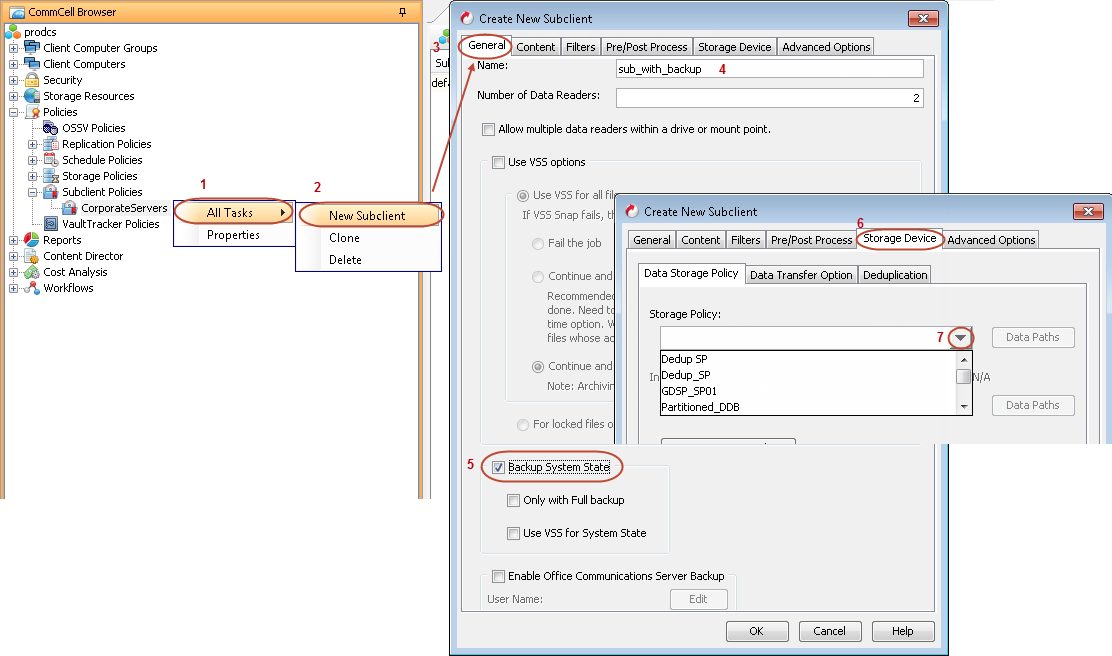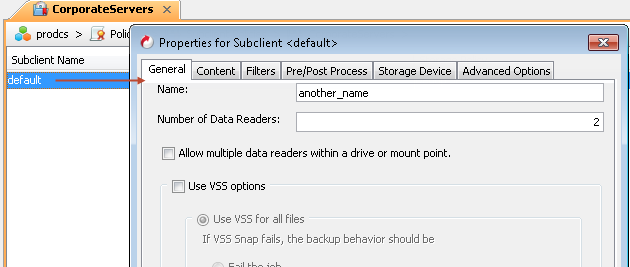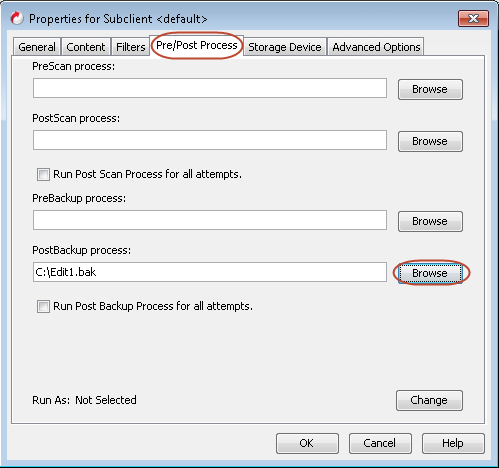Creating User-Defined Subclients for a Subclient Policy
Use the following steps to create a user-defined subclient for an existing subclient policy:
-
From the CommCell Browser, go to Policies > Subclient Policies.
-
Right-click an existing subclient policy and click All Tasks > New Subclient.
-
Enter the name for the new subclient in the Name box.
-
Click the Content tab.
-
Enter the contents for the subclient by browsing to them or by entering their path.
-
Click the Storage Device tab.
-
Select the storage policy from the Storage Policy drop-down list.
-
Click OK.
The user-defined subclient is automatically created for all clients where the subclient policy is associated.

Creating a System State Backup Subclient Policy
Use the following steps to create a system state backup policy:
-
From the CommCell Browser, go to Policies > Subclient Policies.
-
Right-click an existing subclient policy and click All Tasks > New Subclient.
-
Enter the name for the new subclient in the Name box.
-
Select the Backup System State check box.
-
Click the Storage Device tab.
-
Select the storage policy.
-
Click OK.

Managing the Subclients Within a Subclient Policy
Use the following administrative functions to manage subclients associated in your subclient policy.
Renaming the Subclients Associated with a Policy
Use the following steps to rename a subclient:
-
From the CommCell Browser, go to Policies > Subclient Policies > policy.
-
Right-click the subclient and then click Properties.
-
Enter a new name in the Name box.
-
Click OK.

Modifying the Content
Use the following steps to modify the content:
-
From the CommCell Browser, go to Policies > Subclient Policies > policy.
-
Right-click the subclient and then click Properties.
-
Click the Content tab.
-
Click Browse, go to the path that you want to define as the subclient content, and click Add. After defining the content, click Close.
You can also use wildcards to define the subclient content. For more information on available wildcards, see Supported Wildcards.
Note
If the subclient content consists of wildcard characters and no eligible files are found for backup, then the backup operation will complete successfully even though no files were backed up.
-
Click OK.

Changing the Storage Policy
Use the following steps to change the storage policy:
-
From the CommCell Browser, go to Policies > Subclient Policies > policy.
-
Right-click the subclient and then click Properties.
-
Click the Storage Device tab.
-
Select a different storage policy from the list.
-
Click OK.

Changing the Client Associations
Use the following steps to change the client associations of a subclient policy:
Note
If you disassociate a client from a subclient policy, the client retains the properties of the policy.
-
From the CommCell Browser, go to Policies > Subclient Policies.
-
Right-clickan existing subclient policy and click Properties.
The Properties for Subclient Policy dialog box appears.
-
Click the Association tab and change the client associations.
-
Click OK.
Adding Filters
Use the following steps to add a filter:
-
From the CommCell Browser, go to Policies > Subclient Policies > policy.
-
Right-click the subclient and then click Properties.
-
Click the Filters tab.
-
Click Add on the right of Exclude these files/folder/patterns.
-
In the Enter Path window, type the complete path (including drive letter) of the file/folder/directory that you want to exclude from the operation and click OK.
-
Click Add on the right of Except for these files/folders.
-
In the Enter Path window, type the complete path (including drive letter) of the file/folder/directory to specify an exception to an filtered folder/directory and click OK.
You can also use wildcards to define exceptions to filters. For more information on available wildcards, see Supported Wildcards. The wildcards available for defining content of a subclient can be used for defining exceptions to filters.
-
Click OK.

Adding Pre-processes and Post-processes
Use the following steps to add pre-processes and post-processes:
-
From the CommCell Browser, go to Policies > Subclient Policies > policy.
-
Right-click the subclient and then click Properties.
-
Click the Pre/Post Process tab.
-
Click Browse next to the type of pre-process and post-process that you want to add, go to the path to the file with the process, and click Add. Once the path is added, click Close.
-
Click OK.

Enabling End-User Access Control during Backups
You can limit CommCell users to browse/find the files and directories on which they have access. Other files will be filtered out and made invisible during the browse operations.
Use the following steps to configure a subclient with this restriction:
-
From the CommCell Browser, go to Policies > Subclient Policies > policy.
-
Right-click the subclient and then click Properties.
-
Click the Advanced Options tab.
-
Click the Catalog ACL (end user access control list) check box.
Note
If you select/clear this option between backup jobs, it is recommended to run a full backup for the selected option to take effect.
-
Click OK.

Configuring a Subclient for OnePass
You can configure a subclient for OnePass from the subclient policy.
About This Task
You can also configure subclients for OnePass at the subclient level.
-
For Windows, see Configuration - OnePass for Windows File Systems.
-
For UNIX, see Configuration - OnePass for UNIX File Systems.
Procedure
-
From the CommCell Browser, expand Policies > Subclient Policies > policy.
-
Right-click the subclient and then click Properties.
-
On the General tab, type the name of the subclient policy.
For more information about the available options, see Subclient Properties (General).
-
On the Retention tab, select the Extend storage policy retention check box.
-
Select the Job based retention and Object based retention check boxes and set the time period for which you want to retain the archived items. For more information on retention options, see Retention Options for Archiving.
-
In the Archiving Rules tab, select the Enable archiving with these rules check box and set the archiving rules as appropriate.
For more information about the available options, see Archiving Rules.
-
Click OK.
Configuring a Subclient to Run IntelliSnap Backups
Use the following steps to start running IntelliSnap backups for a subclient:
-
From the CommCell Browser, go to Policies > Subclient Policies > policy.
-
Right-click the subclient and then click Properties.
-
Click the Advanced Options tab.
-
Click the IntelliSnap check box.
-
Select a snap engine from the list of Available Snap Engines list.
-
Click Manage Array if you need to configure the storage array to be used by the IntelliSnap backups.
-
Select the client computer from the Proxy list.
-
Click OK.

Deleting User-Defined Subclients from a Policy
When you delete a user-defined subclient, it is removed from the subclient policy and the client to which it is associated.
Use the following steps to delete a user-defined subclient:
Note
Default subclients cannot be deleted.
-
From the CommCell Browser, go too Policies > Subclient Policies >policy.
-
Right-click a subclient in the window to the right and click Delete.
-
Click Yes.

Supported Wildcards
The following table describes the available wildcards in Windows and Unix.
On Windows
Note
The wildcard description and examples below are for filtering files from backup. You can also use these wildcards to backup files (in other words, add files to the backup content).
|
Wildcard |
Definition |
Example |
|---|---|---|
|
* |
Any number of characters. This wildcard is used in following scenarios:
|
C:\*.log will filter all files with the .log extension on root of the C drive. If you want to filter files with the .log extension from a folder on the C drive, you must include the path to the folder in the filter. (for example, C:\Test\*.log) ntuser* will filter all files for which the file name starts with the word ntuser. C:\Finance\Test\* will filter only the files in the "Test" folder under the "Finance" folder on the C drive. Any sub-folders under the "Test" folder will get backed up. C:\* will filter all files located on root of the C drive. |
|
** |
All files and folders under a specific directory All files and folders under a specific drive |
C:\Test\Data\** will filter all files and subdirectories under and including C:\Test\Data C:\**\Data\** will filter all files and subdirectories below and including any directory called "Data" at any level in the C: volume G:\Users\**\xpprofile\*.log will filter all files with the .log extension from any xpprofile subdirectory under Users directory G:\Users\**\xpprofile\ntuser* will filter all filenames starting with ntuser from any xpprofile subdirectory under Users directory C:\** will filter all the directories located on C drive C:\**\* will filter all the files and directories on C drive |
|
? |
Any one character This wildcard can be used to filter following files or folders: All files (or folders) for which any one character in the file name or the folder name is variable. |
To filter files: C:\access?.doc will filter any files with the extension .doc on the C drive for which the name begins with- "access" followed by any one character such as access1.doc or access5.doc. However, access12.doc or access15.doc will not be filtered because the last two characters in the name are variable. To filter access12 or access15, you must specify access?? in the subclient filters. To filter folders: Class?report will filter any folder for which the character in the place of ? is variable. For example: Class1report and Class2report will be filtered. However, Class15report will get backed up. |
|
[ ] |
Set or range of characters. |
C:\[a-m]*.doc will filter any file with .doc extension on the C drive for which the name begins with the letters "a" through "m”. C:\[AEIOU]*.doc will filter any file name that ends with .doc and begins with the letters A, E, I, O, or U. If you want to treat [] as literal characters and not as wildcards, you must use a special syntax. This will be useful when you want to filter a file which has [] in the file name. The special syntax allows you to define an escape character. Each character immediately following the escape character will then be treated literally and not as a wildcard. For example: You want to filter a file with the name report[finance].doc on the C drive. In order for the square brackets to not be treated as wildcards, you must define an escape character. In the following example, the escape character is defined as the apostrophe (‘). The "e=" syntax is used to define the escape character. Since the square brackets are to be treated as literals, they both must be preceded by apostrophes. The filter entry in the subclient should look like this: <P:e='>C:\report'[finance'].doc Any character can be used as the escape character, as long as it is defined after the “e=” in the syntax and it precedes any character that is to be treated as a literal. In addition, the escape character can itself be used as a literal. This can be achieved by prefixing it with another escape character. To filter a file with the name Test[Report]’2011’Financials.doc on the C drive, the following syntax should be used: <P:e=’>C:\Test’[Report’]’’2011’’Financials.doc |
|
[!] |
The negation of a set or range of characters. You can use the wildcard in following scenario: Filter all files in a directory except the files for which the name starts with any character from the specified set or range of characters. |
C:\Windows\[!AEIOU]*.doc will filter all .doc files in the C:\Windows directory that start with a letter other than A, E, I, O, or U. |
On UNIX
Note
The wildcard description and examples below are for filtering files from backup.
|
Wildcards |
Description |
Examples |
|
* |
Any number of characters. This wildcard is used in the following scenarios:
|
*.doc will backup all files with the extension .doc (e.g., status.doc, mission.doc) on all partitions on the client computer. /Test/*.doc will backup all .doc files only in the /Test directory a*.so will backup all files with the extension .so (e.g., alsvc.so, advdcc.so) on the client computer which have the name beginning with "a". /Finance/Test/* will backup all the files and directories in the "Test" directory under the "Finance" directory on the / partition. Any sub-directories under the Test directory will not get backed up. |
|
? |
Any one character. This wildcard can be used in the following scenario: All files (or directories) for which any one character in the file name or the directory name is variable. |
/access? will backup any directory or file on the machine for which the name begins with- "access" followed by any one character such as access1 or access5. However, access12 or access15 will not backup because the last two characters in the name are variable. /Class/report? will backup any directory or file under /Class directory for which the character in the place of ? is variable. For example: /Class/report1 and /Class/report2 will back up. However, /Class/report15 will not get backed up. |
|
[] |
Set or range of characters. |
/[a-m]*.doc will back up any file with .doc extension on the / partition for which the name begins with the letters "a" through "m”. /[AEIOU]*.doc will back up any file name that ends with ..doc and begins with the letters A, E, I, O, or U. /Finance/report[1-47-9] will backup files report1, report2, report4, report7, report8, report9 under Finance directory. /Department-[A-CS] will backup files Department-A, Department-B, Department-C and Department-S. |
|
[!] |
The negation of a set or range of characters. You can use the wildcard in the following scenario: Back up all files in a directory except the files for which the name starts with any character from the specified set or range of characters. |
/root/[!AEIOU]*.doc would backup all .doc files in the /root directory that start with a letter other than A, E, I, O, or U. |
|
** |
Any number of characters across any number of path levels. |
/**/move.cpp - the file named move.cpp located at any directory level. (e.g., /root/newapp/move.cpp/opt/kde3/src/move.cpp) /etc/** - will backup all directories and files under /etc. All the sub-directories under these directories will also be included. |
When you use wildcards to specify the subclient content, the content path appears in Italics.
If you want all the files with the file extension ".doc" to be backed up from any level, then specify the content as *.doc. If any subclient content doesn’t start with /, then /**/ will be prefixed to the content to match at any level. E.g., *.doc will be /**/*.doc
If user wants to treat *, ?, [ ] as literals in the SC content and not as wildcards, then the user can escape the wildcard by adding ‘\’ before the wildcard. E.g., /Report\[2011-2012\]/*.doc backups all the .doc files under /Report[2011-2012]
More than one type of wildcard can be used when specifying subclient content (e.g., /Dcvol?/oracle[1-47]/**/*.log).
Renaming a Subclient Policy
Use the following steps to rename a subclient policy:
-
From the CommCell Browser, go to Policies > Subclient Policies.
-
Right-click an existing subclient policy and click Properties.
-
In the Properties for Subclient Policy dialog box in the Name box, enter a new name.
-
Click OK.
Cloning a Subclient Policy
Cloned subclient policies retain the properties of their parents but not their backup set associations.
Use the following steps to clone an existing subclient policy:
-
From the CommCell Browser, go to Policies > Subclient Policies.
-
Right-click an existing subclient policy and click All Tasks > Clone.
-
Enter a unique name for the cloned policy and click OK.
Deleting a Subclient Policy
When you delete a subclient policy, its associated clients retain the properties of the policy.
Use the following steps to delete a subclient policy:
-
From the CommCell Browser, go to Policies > Subclient Policies.
-
Right-click an existing subclient policy and then click All Tasks > Delete.
-
Click Yes in the message.
Managing Subclient Policy from the Subclient Level
You can associate a subclient policy to the backup set directly from the default subclient level or backup set level.
During installation, a default backup set is automatically created, which contains a default subclient. The default subclient automatically detects and protects all the data that the agent is responsible to protect.
Assigning Subclient Policy from Default Subclient Level
For the backup set, you can associate the subclient policy from the default subclient.
-
From the CommCell Browser, go to Client Computer > Client.
-
Navigate to File System > backupset name > default.
-
Right-click default subclient and click Properties.
-
In the Subclient Properties of default dialog box from the Subclient Policy list, select the subclient policy you want to associate.
-
Click OK.
Assigning Subclient Policy from Backup Set Level
For the backup set, you can associate the subclient policy from the back up set level.
-
From the CommCell Browser, go to Client Computer > Client.
-
Navigate to File System > backupsetname.
-
Right-click backupsetname and click Properties.
-
In the Backup Set Properties dialog box from the Subclient Policy list, select the subclient policy you want to associate.
-
Click OK.